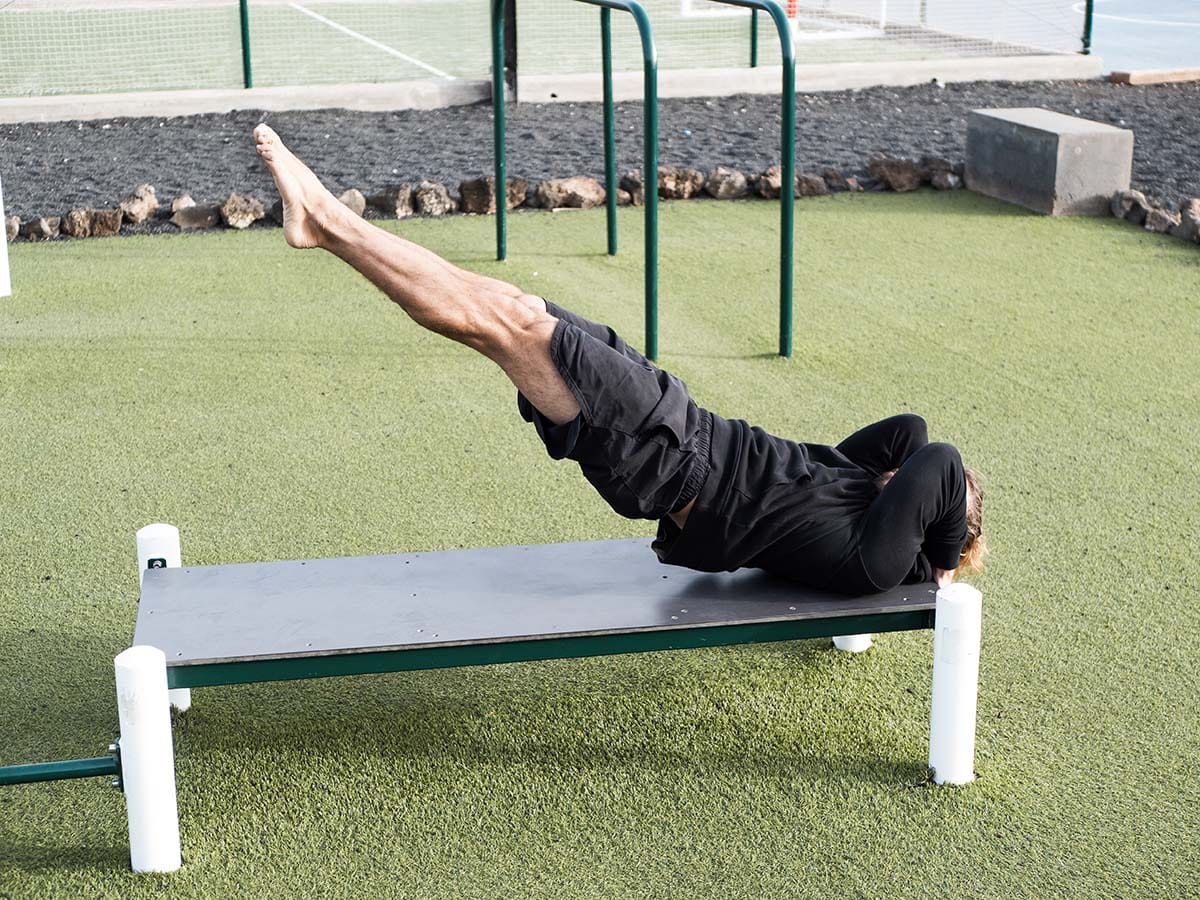Dragon Flag Exercise: Build Strength Like a Dragon!
Dragon flag exercise is a compound core exercise that can help you build your pecs. Want a six-pack? Get ready to learn more about this exercise
When it comes to core strengthening exercises, the dragon flag exercise stands out as one of the most challenging and impressive maneuvers.
Made famous by martial arts legend Bruce Lee, this exercise is not just a testament to core strength but also a full-body workout that can elevate your fitness routine.
If you're ready to take your core workout to the next level, understanding how to properly execute the dragon flag exercise is crucial.
What is the Dragon Flag Exercise?
The dragon flag exercise is a core-strengthening movement that involves lowering and raising your body while keeping it rigid and straight, using your upper back and shoulders as the only points of contact with the bench or floor.
It requires significant core strength, stability, and control, making it an advanced exercise not typically recommended for beginners.

History and Origins of the Dragon Flag
The legend says the dragon flag exercise rose to fame through Bruce Lee, renowned not only for his martial arts prowess but also for his incredible physical conditioning.
Lee incorporated this exercise into his training regimen to develop unmatched core strength and body control, which contributed to his agility and power in martial arts.
Over time, the dragon flag has been embraced by fitness enthusiasts and athletes aiming to achieve a similar level of strength and discipline. Its association with Lee has made it a symbol of the peak of physical fitness and martial arts mastery. It also looks very cool!

Muscle Engagement During the Dragon Flag Exercise
The dragon flag is not just an exercise for the abs, it's a compound core exercise that engages multiple muscle groups throughout the body. Here's a closer look at the muscles involved:
- Core Muscles: Primarily, the exercise targets the rectus abdominis, the "six-pack" muscles, as well as the transverse abdominis, which act like a corset to stabilize the spine. The obliques are also engaged to maintain lateral stability.
- Hip Flexors and Glutes: These muscles work in tandem to keep the lower body aligned. The hip flexors help lift the legs, while the glutes stabilize the pelvis and provide power during the movement.
- Upper Body Muscles: The deltoids, triceps, and lats are engaged to keep your upper back and shoulders steady on the bench. These muscles work isometrically, meaning
- Leg Muscles: Even the quads and calves are involved as you maintain a straight line from shoulders to toes, requiring full-body tension and coordination.
Understanding the anatomy involved in the dragon flag highlights its effectiveness as a compound exercise that strengthens your entire body, not just your core.
Benefits of the Dragon Flag Exercise
- Core Strength: It robustly targets your entire core, providing strength that supports various physical activities.
- Full-Body Engagement: Engaging muscles from your shoulders to your toes ensures a holistic workout experience.
- Improved Stability and Control: Enhances balance and body control, beneficial for other exercises and daily activities.
- Increased Athletic Performance: Contributes to better performance in sports, enhancing power, endurance, and agility.

How to Perform the Dragon Flag Exercise
To get the most out of the dragon flag exercise, proper form is essential. Here’s a step-by-step guide to performing this challenging move:
- Find a sturdy, flat surface like a bench. Lie back on the bench with your head near the edge.
- Grip the sides of the bench or a stable overhead anchor to provide support.
- Bring your knees towards your chest, lifting your hips off the bench.
- As you do this, straighten your legs so your body forms a straight line from shoulders to feet.
- Keeping your body straight and rigid, slowly lower your legs towards the bench. Your body should remain in a straight line, pivoting from the shoulders.
- Lower until your back is just above the bench without touching it.
- Reverse the movement, raising your body back to the starting position.
- Focus on a slow, controlled descent and ascent to maximize time under tension.
- Exhale as you lower your body and inhale as you return to the starting position.
Progressions and Modifications
The dragon flag exercise is advanced, so it’s important to build up to it if you’re not quite ready. Here are some progressions and modifications to consider:
- Bent-Knee Flags: Start with your knees bent to reduce the intensity and focus on maintaining a straight spine.
- Partial Dragon Flags: Lower only halfway and then return to the starting position, gradually increasing the range of motion as you gain strength.
Common Mistakes to Avoid
- Using Momentum: To truly benefit, avoid swinging your legs or using momentum. Focus on controlled movement.
- Arching the Back: Maintain a neutral spine to protect your lower back from strain. Keep your core engaged to prevent arching.
- Rapid Movements: Slow and controlled is key. Fast movements reduce efficacy and increase injury risk.

Incorporating the Dragon Flag into Your Routine
While the dragon flag exercise is excellent for core strengthening, it shouldn’t be the only exercise in your routine. Here’s how to incorporate it effectively:
- Core Workouts: Add the dragon flag at the end of your core workout when your muscles are fully warmed up.
- Full-Body Routines: Pair it with other bodyweight exercises like pull-ups, push-ups, or squats for a comprehensive workout.
Complementary Exercises
To support your journey to mastering the dragon flag exercise, consider incorporating these complementary exercises into your routine:
- Planks: Build foundational core strength with plank variations like side planks and plank holds.
- Hanging Leg Raises: Develop the lower abdominal strength necessary for the dragon flag.
- Reverse Crunches: Focus on the lower abs and practice lifting your hips off the ground.
Safety Considerations
Performing advanced exercises like the dragon flag requires awareness and caution to prevent injury:
- Warm-Up Thoroughly: Always warm up with dynamic stretches and lighter exercises to prepare your muscles for the intense workload.
- Listen to Your Body: Pay attention to your body’s signals. If you feel pain or discomfort (beyond normal muscle fatigue), stop and reassess your form.
- Proper Recovery: Ensure you allow your body time to recover with proper nutrition, hydration, and rest days.
FAQs About the Dragon Flag Exercise
1. Is the dragon flag exercise suitable for beginners?
The dragon flag is an advanced exercise and is typically not recommended for beginners. It’s important to build a solid foundation of core strength before attempting it. Beginners should start with easier core exercises, gradually progressing to more challenging moves.
2. How often should I practice the dragon flag exercise?
As part of a balanced workout routine, you can practice the dragon flag exercise 1-2 times per week. It’s crucial to allow adequate recovery time between sessions as this exercise is demanding on the muscles.
3. What are the alternatives if I can’t perform a dragon flag yet?
If you’re not ready for the dragon flag, consider alternatives like leg raises, long lever planks and hollow body holds to build the necessary strength and stability.
Final Word
The dragon flag exercise is a formidable addition to any fitness regimen, offering unparalleled benefits for core strength and full-body control. By understanding the nuances of this exercise, you can effectively integrate it into your routine and feel like a martial arts legend in your own right.
We’ve made it simple to work on customized fitness plans or to introduce a little friendly competition to your fitness community by sharing exercises with your friends. Get started for free through the Flex fitness app.
Related articles


Get fit with Flex
Build muscle & lose weight fast for free.
Available on iPhone + Apple Watch





